The Ancient Town of Si Thep and its Associated Dvaravati Monuments
By Rachel Heller
What is the Ancient Town of Si Thep and its Associated Dvaravati Monuments?
Thailand’s newest UNESCO site includes three parts: the remains of a town, an ancient monument outside of town, and a cave in a mountain. All three were products of the Dvaravati Empire, which ruled in central Thailand from the 6th-10th centuries AD.
Disclosure: This article contains affiliate links. Making a purchase through an affiliate link will mean a small commission for this website. This will not affect your price.
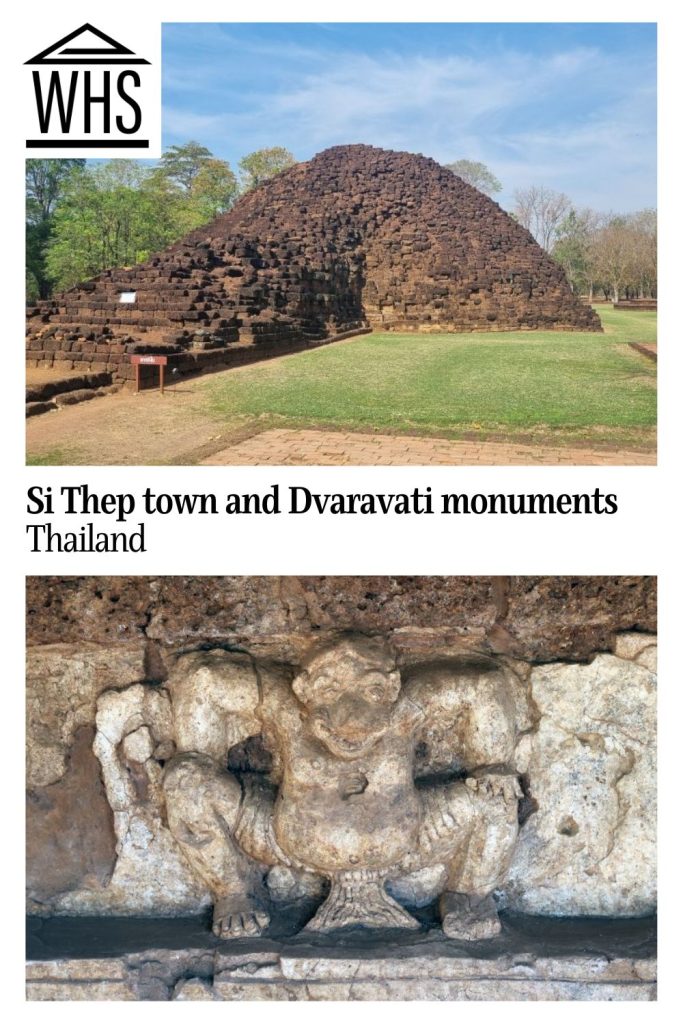
1. Si Thep
The town of Si Thep is the main property. Made up of an inner and an outer town, both of them surrounded by walls and moats, it covers about 4.7 square kilometers (1.8 square miles) and contains the ruins of more than 100 structures. These structures show an artistic style now called the Si Thep School of Art, influenced by Hindu culture in India combined with local influences.
The inner town (called Muang Nai) is more or less round and is protected as Si Thep Historical Park, while the outer city (Muang Nok), presumably added later, is a rectangle added onto the original circle. The outer city is not part of the UNESCO designation because, while it contains remains of 54 structures, it is used today for agriculture.
2. Khao Klang Nok Monument
This component is about two kilometers outside of the Si Thep site and is an enormous pyramidal structure, once a temple or monastery.
3. Khao Thamorrat Cave
The third component is a cave that also had a religious function during the Dvaravati period. It has bas-relief sculptures carved into its walls.
Why is Si Thep a UNESCO World Heritage site?
Si Thep is on the list for two main reasons. First of all, it represents interchanges among cultures, in this case traditions from India, and how they were adapted during the Dvaravati Empire period. The Si Thep School of Art then went on to influence art and architecture elsewhere in Thailand. The UNESCO listing adds that “The cohabitation of Theravada and Mahayana Buddhism and Hinduism is a distinctive characteristic of Dvaravati architecture, town planning and art, and these are demonstrated by the three component parts.”
Secondly, the sites “bear an exceptional testimony to the Dvaravati culture and civilisation.” Their art and architecture are unique to this region.
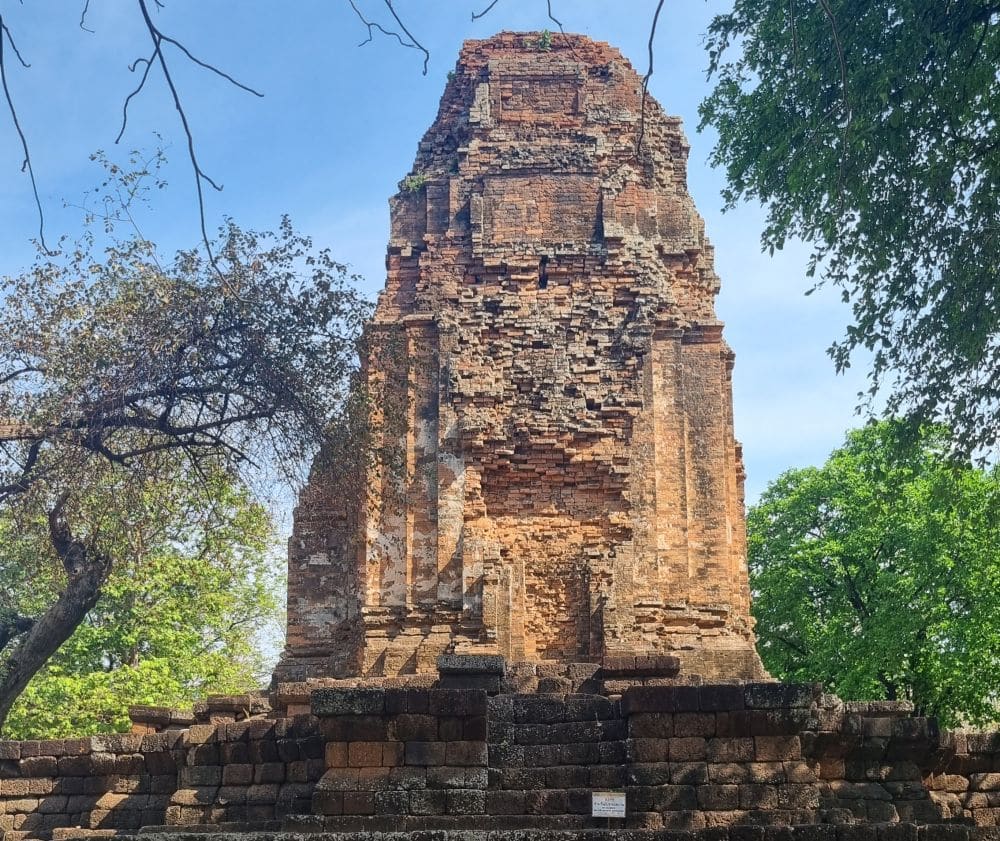
What can you expect on a visit to Si Thep?
Si Thep
The inner town site is now a pleasant shady park. From the entrance gate, electric shuttle buses (included in the entrance fee) run a route around the site, or you’re welcome to walk. You’ll notice things like small ponds, ancient pavements and walls, and foundations of buildings here and there, but there are four things in particular that are worth a stop.
Two prangs, which are tall spires that are central to shrines, face west along a single axis toward Khao Thamorrat mountain, where the cave is. Between them are low walls and restored pavements that give an idea of the building complex that once stood here. These prangs date to later periods: one to the Khmer culture period (10th-12th centuries AD) and the other to the early Angkor Wat period just before that (10th-11th centuries). Both were built on top of Dvaravati structures. They are made of brick on laterite stone foundations.
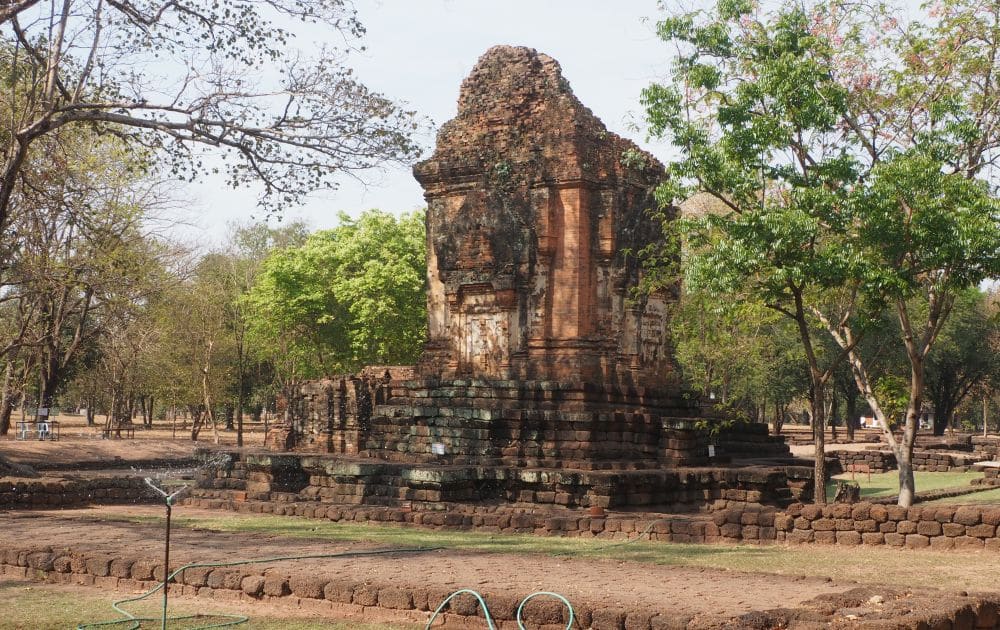
More interesting is the large structure nearby: Khao Klan Nai Monument. Unlike the prangs, it dates from the Dvaravati period. From a distance it looks like a big pile of loose stones, but closer up you can see it forms a pyramid structure on a rectangular base. It is 44 meters (144 feet) by 88 meters (289 feet) and 12 meters high (39 feet). One end has a porch with what used to be a staircase to the top. In its day, a temple or stupa (spire) would have stood on the monument’s flat top.
A small section of Khao Klan Nai’s outer layer remains, now sheltered under a section of roof on one side of the monument. There, you can see some of the stucco work that once covered the whole structure. The human and animal-headed figures are “supporting dwarves” and more abstract decorations are also visible.
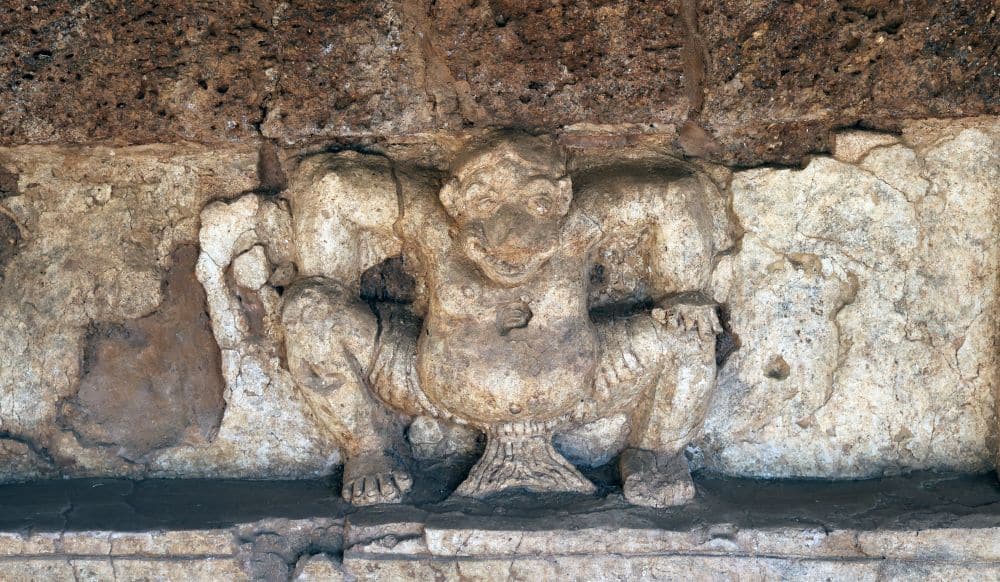
A small modern building shelters some archeological finds: skeletons, which have been left where they were found. One, the most complete, is a very tall woman, with jewelry and pottery on and around her. At a higher level – so from a later period – is a partial elephant skeleton, also deliberately buried.
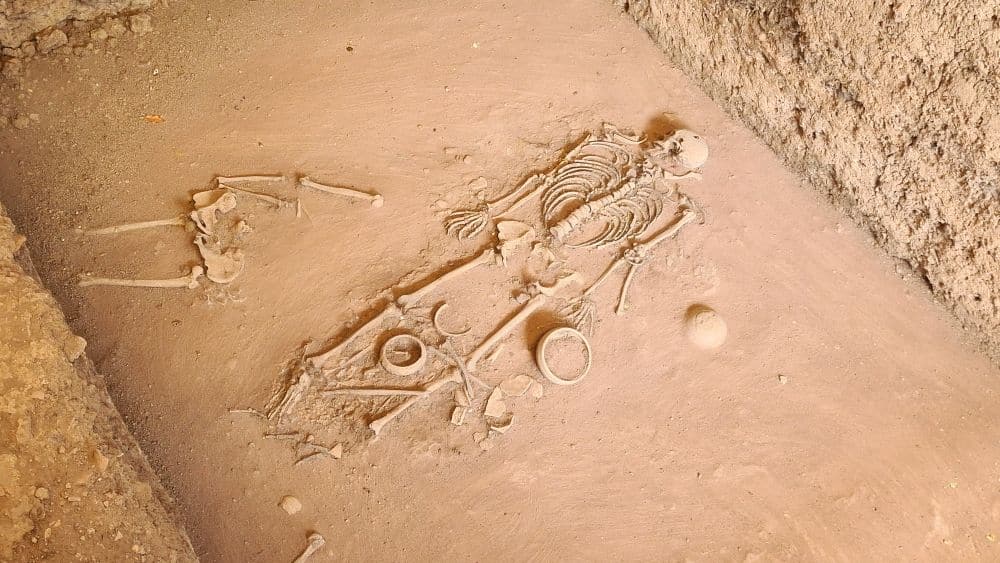
There is a small food kiosk on the site, as well as a toilet block. Eventually a new facility at the entrance will include both as well.
Khao Klang Nok Monument
Outside of Si Thep is this large monument. Like Khao Klang Nai, it is a stone pyramidal structure, square in this case, and much, much bigger: 64 meters (210 feet) on a side and 20 meters (66 feet) high, though it would have been higher back then. It has two stepped levels with a flat top, where a large pile of bricks indicate that there was another level. One theory is that a bell-shaped pagoda stood on it.
On each side of the monument is a very large, grand staircase. The indented corners of the base of the monument derive from an Indian style and became part of the Si Thep style, as do other elements of the design.
Visitors are no longer allowed to climb the stairways for fear of damaging the monument or getting hurt.
Small market stalls sell handicrafts and snacks nearby, but I did not see any toilet facility here.
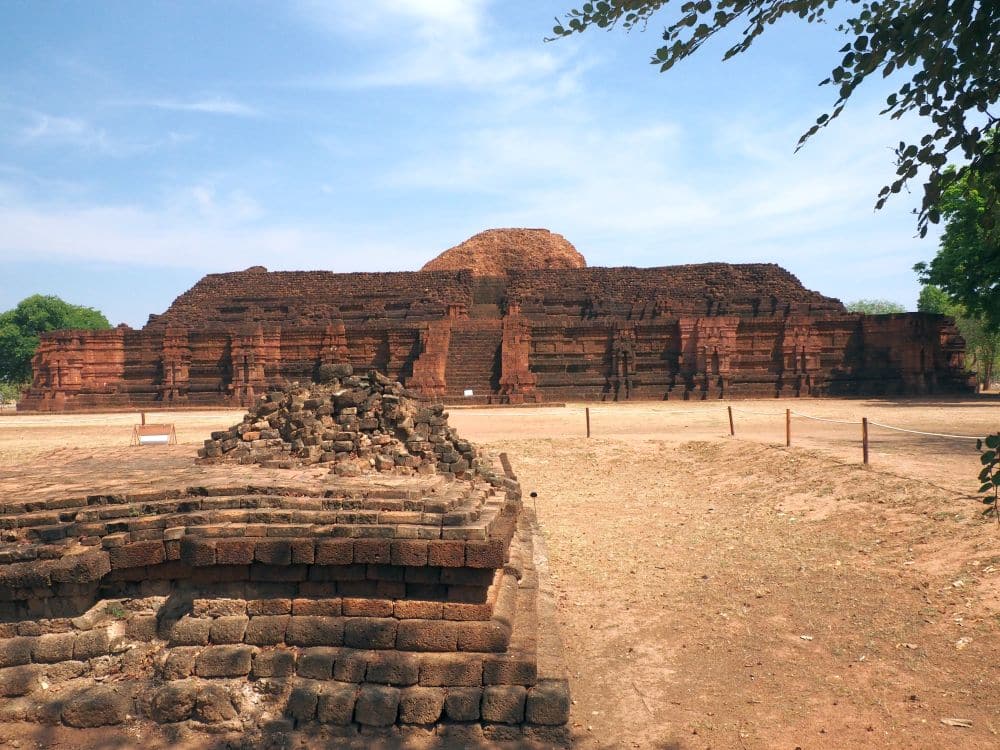
Khao Thamorrat Cave
I have not seen Khao Thamorrat Cave. Few people have, as it’s very hard to access and isn’t open to the general public. Khao Thamorrat is a mountain, and the two prangs in Si Thep, along with the inner town’s central walkway, are all aligned west toward this mountain. This implies a religious belief about the mountain.
The cave is 584 meters (1,916 feet) above sea level and may have served as a monastery. It holds several groups of sculptures including standing and sitting Buddha images. Many are quite damaged, and several heads have been removed. Some heads are on display at the National Museum in Bangkok.
The only way to get to the cave, apparently, is by hiking there on a rough track. It’s only allowed with an authorized guide.
Are the Ancient Town of Si Thep and its Associated Dvaravati Monuments worth visiting?
Given that there are more impressive temples from somewhat later periods in Thailand at places like Sukhothai and Ayutthaya, I’d say it’s only worth visiting if you have particular interests in its elements. In other words, if you’re into Dvaravati period art and architecture or if you’re a UNESCO site geek, you might enjoy it. Of course, if you’re traveling this way anyway, by all means stop and take a look.
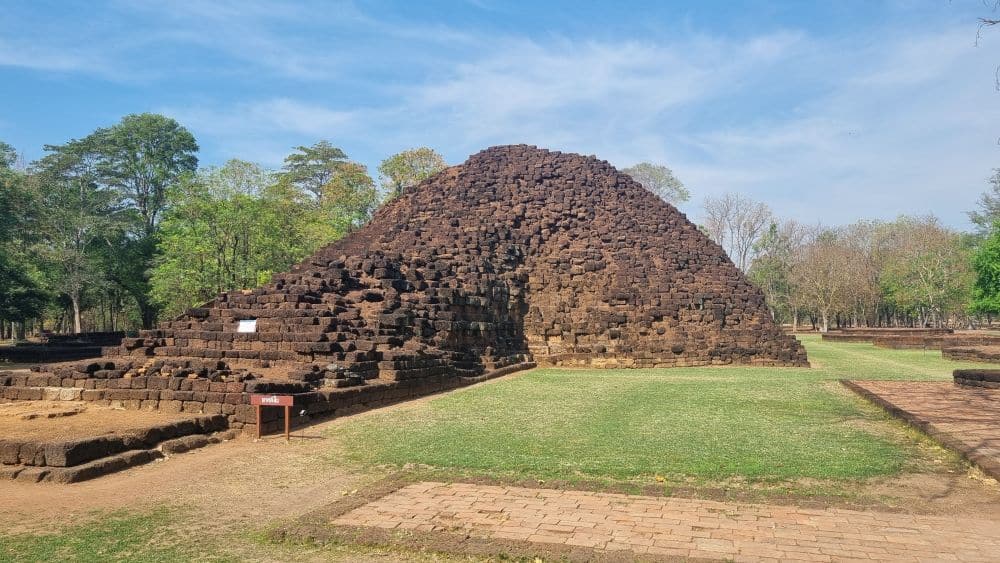
Tips for visiting Si Thep
We spent about an hour at Si Thep and another half-hour or so at Khao Klang Nok, and that was about enough. If you are a hiker and want to get to the cave, ask at the entrance gate or call (6656) 921-322 or the tourist information center at (6656) 921-354 to find out how to arrange it.
It’s hot in Thailand: so hot it can get oppressive. The site has lots of shade, but still, prepare for the heat by bringing water along as well as a sunhat and sunglasses.
Use the map below to find accommodations near Si Thep:
Where is Si Thep?
Si Thep is in central Thailand, 240 kilometers (150 miles) north of Bangkok. From Ayutthaya, it’s about 180 kilometers (112 miles). Pretty much the only way to get there is by car, and it’ll take you between three and three and a half hours to get there from Bangkok. From Ayutthaya it’ll take an hour less than that. The roads are good, but they aren’t superhighways. Rent a car, or else take a tour like the one I took (which was sponsored) with Thailand Journeys. That included other interesting sights on the way to and from Si Thep.
For more information about Si Thep, its opening hours and admission fees, see its official website.
Have you been to Si Thep? If so, do you have any additional information or advice about this UNESCO World Heritage site? Please add your comments below!

